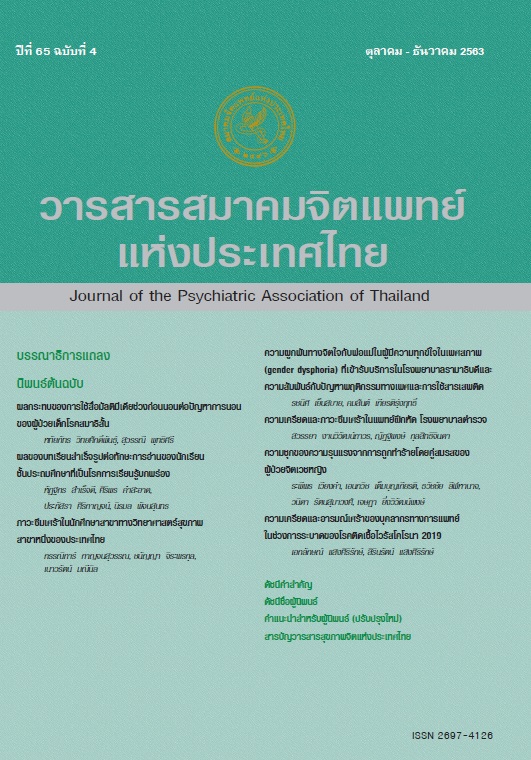Prevalence of Intimate Spouse Violence among Female Patients with Mental Illnesses
Main Article Content
Abstract
Objective : To study the prevalence of physical abuse, mental abuse, and sexual abuse among women with mental illnesses, and factors associated with intimate partner violence.
Method : A cross-sectional descriptive study was conducted. The participants were 127 female who received treatment in the Psychiatry Department at Thai Army Hospital in 2018. All participants self-administered questionnaires, including demographic data and intimate partner violence assessment form, index of spouse abuse (ISA) in the Thai version.
Results : The prevalence of intimate partner violence among women with mental illnesses was 44.9%, which 16.5% was physical abuse, 37.8% was mental abuse, and 19.6% was sexual abuse. Patients who have violence more than one aspect of abuse were 15% and found that 17% encountered physical abuse together with mental abuse, 16% encountered with all 3 aspects of abuse. The highest prevalence was found in major depressive disorder (37 patients; 29.1%, in this group found violence abuse of 38.6%, followed by 33 patients with generalized anxiety disorder (26%), in this group found violence abuse of 21.1%, 14 patient with schizophrenia (11%) and 10 patients with disorder (7.9%). Factors that significantly associated with intimate partner violence were consisted of 8 factors, which were wife’s age, wife’s occupation, husband’s substance addiction, husband’s gambling addiction, wife who had been victims of childhood abuse, husband who had been victims of childhood abuse, wife who had been in abusive family, and husband who had been in abusive family. When analysing all 8 factors with multiple logistic regression, it is found that the most influential factors are unemployed wife, wife’s age between 40-49 years old, and a husband who had been in the abusive family.
Conclusion : Intimate partner violence has been increasing comparison to previous studies. This study found that the highest prevalence of violence is mental abuse, followed by sexual abuse, and physical abuse respectively, it is found that the most influential factors are unemployed wife, wife’s age between 40-49 years old, and a husband who had been in the abusive family.
Article Details
Articles submitted for consideration must not have been previously published or accepted for publication in any other journal, and must not be under review by any other journal.
References
2. Friedman SH, Loue S. Incidence and prevalence of intimate partner violence by and against women with severe mental illness. (1540-9996 (Print)).
3. Jatchavala C, Udomratn P. Women and Gender, Diversity and Mental Health In: Bährer-Kohler S., Bolea-Alamanac B.(editors). Diversity in global mental health Gender, Lifespan, Access to care, Treatment and Social Strata. The Netherland: Springer; 2019: 31-40.
4. Howard LM, Trevillion K Fau-Khalifeh H, Khalifeh H Fau-Woodall A, Woodall A Fau-Agnew-Davies R, Agnew-Davies R Fau-Feder G, Feder G. Domestic violence and severe psychiatric disorders: prevalence and interventions. (1469-8978 (Electronic)).
5. Khalifeh H, Dean K. Gender and violence against people with severe mental illness. Int Rev psychiatry 2010; 22: 535-46.
6. World Health Organization. Violence against women. World Health Organization 2017. [Accessed Nov 10, 2018]. Available from: http://www.who.int/en/news-room/fact-sheets/ detail/violence-againt-women.
7. Sparrow K, Kwan J, Howard L, Fear N, MacManus D. Systematic review of mental health disorders and intimate partner violence victimisation among military populations. Soc Psychiatry Psychiatr Epidemiol 2017; 52(9): 1059-80.
8. Chuemchit M, Chernkwanma S, Rugkua R, Daengthern L, Abdullakasim P, Wieringa SE. Prevalence of Intimate Partner Violence in Thailand. J Fam Violence 2018; 33(5): 315-23.
9. Jonas S, Khalifeh H, Bebbington E, McManus S, Brugha T, Meltzer H, et al. Gender differences in intimate partner violence and psychiatric disorder in England : results from the 2007 adult psychiatric morbidity survey. Epidemiol Psychiatr Sci 2014; 23: 189-99.
10. Khalifeh H, Moran P, Borschmann R, Dean K, Hart C, Hogg J, et al. Domestic and sexual violence against patients with severe mental illness. Psychol Med 2015; 45: 875-86.
11. Hutabaedya B. Wife Abuse in ASEAN and Thai Families. Journal of human ecology Bangkok, Thailand. 2014: 6-18.
12. Trevillion K, Oram S, Feder G, Howard LM. Experiences of domestic violence and mental disorders: a systematic review and meta-analysis. PLoS One 2012; 7(12): e51740.
13. Ouellet-Morin I, Fisher HL, York-Smith M, Fincham-Campbell S, Moffitt TE, Arseneault L. Intimate partner violence and new-onset depression: a longitudinal study of women’s childhood and adult histories of abuse. Depress Anxiety 2015;32(5):316-24.
14. Abramsky T, Watts CH, Garcia-Moreno C, Devries K, Kiss L, Ellsberg M, et al. What factors are associated with recent intimate partner violence? findings from the WHO multi-country study on women’s health and domestic violence. BMC Public Health 2011; 11(1): 109.
15. World Health O, Pan American Health O. Understanding and addressing violence against women : intimate partner violence. Geneva: World Health Organization; 2012 2012. Contract No.: WHO/RHR/12.36.
16. Jatchavala C, editor Romantic Relationships and Mental Health of Adolescents 2016. [Accessed July 31, 2020]. Available at:


